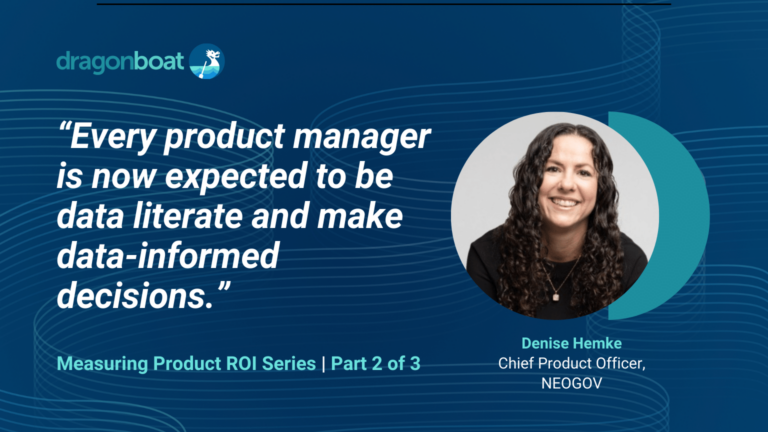Executive Summary
With the rise of knowledge workers and distributed teams, companies are shifting away from a short-term, top-down project-based work culture, to a multi-horizon, agile, collaborative product ownership approach.
Moving from a project to a product-centered mentality requires a culture change that does not happen quickly. If you want complete project-to-product transformation, unique areas throughout your organization will require holistic change.
We found out, through the extensive experiences of our team, customers, and community members, that many people face these challenges:
- Project-based planning and delivery
- No visibility into other parts of the organization
- A reactive approach to planning, strategizing, and team allocation
- Focused on near-term results
- No single source of truth to continuously share progress
This article covers the learnings, observations, and experiences that prove helpful for organizations maneuvering the project-to-product transformation process.
CPOs Can Lead the Charge
A big part of any transformation will be around becoming outcome-focused. To do so, someone must champion a new paradigm—a portfolio management approach that aligns, synchronizes, and optimizes outcomes across your entire company.
So, who leads this charge?
A Chief Product Officer (CPO) is a great place to start. The CPO champions a portfolio management approach that progresses the organization’s outcomes.
A CPO driving the project-to-product transformation focuses on:
- Motivating teams and keeping them aligned on the overarching vision and mission
- Helping navigate internal stakeholders to keep the product org viewed as a strategic partner as each functional area begins their change management process
- Making the best investment decisions that drive outcomes
Becoming outcome-focused doesn’t happen overnight. It’s a journey. But there is a framework that many of today’s successful organizations use to guide the way.
The Hierarchy of Needs
As the change touches nearly every part of the organization, an integrated system must be implemented to support the change. To do so, you may need to understand the needs and interactions across roles and activities.
The hierarchy of needs helps teams understand how they operate today while giving them a path forward to achieve the desired transformation. The following areas make up the hierarchy:
- Building roadmaps
- Managing portfolios
- Delivering outcomes
Each level contains a mix of the other components as an evolution that builds upon the foundation you laid in the previous area.
We recently wrote in-depth about this topic and covered everything from product ROI to outcome-focused roadmapping. Check out the entire framework and visual pyramid here.
Connect OKRs and Initiatives
For a project-to-product transformation to work, you need a single source of truth for product decisions. This requires the ability to connect OKRs and strategic initiatives.
- Top-down: Align OKRs and strategies across all levels of your organization
- Bottom-up: Empower innovation to achieve company-wide goals
- Across team: Collaboration and dependency support
Communicating top-down alignment and showing visible support combined with bottom-up execution is a much more positive experience than a siloed approach led by individual teams.
Along with top-down support, all areas involved in building and supporting your product must be on board with the transition. It might be more challenging for some functions than others. For example, the finance team might struggle with product-based thinking because it isn’t necessarily how budgets have been traditionally managed or how they are accustomed to viewing the ROI.
The CPO and other leadership must demonstrate empathy to these and other departments that may be resistant to change to garner their support.
Proper Portfolio Allocation
Transitioning from managing projects to managing a product portfolio requires proper resource planning and allocation. Organizations need to change from feature-based roadmaps to outcome-driven roadmaps.
Leveling up to a portfolio allocation mindset enables you to:
- Achieve both long-term vision and near-term results
- View the entire product portfolio through different lenses
- Set target allocations by various swimlanes or bets
- Review planned allocation and make real-time adjustments
Many Dragonboat customers use the Responsive Product Portfolio Management (Responsive PPM) framework to accomplish the above. Responsive PPM connects objectives, customer needs, products, and resources with execution. It accelerates outcomes responsive to the state of the organization and the market.
Unlike traditional project-based execution, which focuses on a group of projects and centralized governance, Responsive PPM focuses on continuously evolving products. This allows portfolio leaders to adapt and adjust in real-time to increase outcomes and product ROI.
Align on Metrics
During your transition from project to product, you will inevitably discover that every department has different KPIs that matter to them. This can create misalignment and strategies that work against each other.
To measure the success of your product, you need more than just monetary value. You need to replace ROI with Metrics over Available Resources or MoAR.
MoAR is the ratio of relevant contribution of a product feature towards a metric used to measure a business outcome over the number of resources needed to achieve this contribution.
The MoAR formula enables a direct and holistic measure for portfolio planning and a clearer vision of product portfolio metrics. For a full breakdown of how it works, read the blog post “Forget ROI, Use MoAR for Product Portfolio Metrics.”
Remember that metrics viewed in isolation across various functions without understanding dependencies cause trouble. Metrics on…
- Engineering velocity
- Customer NPS
- User engagement
- Product delivery
…are all great but ineffective if not mapped back to business results.
Leverage Product Operations to Drive Transformation
Although we’ve only mentioned a few areas you’ll have to address in your project-to-product transformation, you will need someone to keep all the moving pieces connected. This is where product operations, or product ops, come into play.
The role of product ops is to enable an effective outcome-focused product organization, or a product-led company, to achieve the best portfolio outcomes.
Phenomenal product op professionals help:
- Clarify strategy across all levels
- Drive responsive execution that delivers commitments
- Help to scale without the business-damaging chaos
- Lead the adoption of data-informed decision making
- Balance long-term vision and short-term outcomes to win in the current and future market
How does a product ops team accomplish the above? You can group their work into eight areas:
- Evolve product and p[ortfolio processes and tooling
- Lead strategic and portfolio planning
- Strengthen portfolio visibility and stakeholder engagement
- Help define customer and user engagement initiatives
- Standardize product analytics, experimentation, and launch planning
- Advise on financial planning
- Coordinates product tools and processes
- Drives operational excellence through partnerships with leadership and HR
Conclusion
Understanding and executing across the areas mentioned in this post enable you to help drive your organization’s transformation. With thoughtful planning and helpful resources, you will achieve the project-to-product transformation you’ve been looking for.
Our team is also here to support your efforts—book time today for a customized demo to see first-hand what Dragonboat can do.





